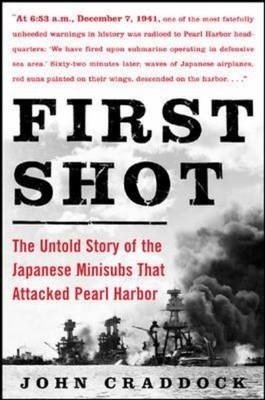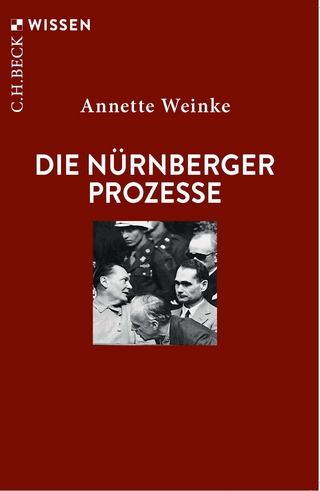
First Shot
Seiten
2006
McGraw Hill Higher Education (Verlag)
978-0-07-143716-5 (ISBN)
McGraw Hill Higher Education (Verlag)
978-0-07-143716-5 (ISBN)
- Titel erscheint in neuer Auflage
- Artikel merken
Zu diesem Artikel existiert eine Nachauflage
Offers an account of the sinking of a Japanese midget submarine, one hour before the Pearl Harbor attack. This title chronicles the stories of the discovery and the naval engagement, and explores the what-if question in our nation's history: If the warning signs had been heeded, would the outcome of the Japanese air attack have been different?
Unheeded warnings, missed opportunities, a failure to connect the dots—more than 60 ago, America was rocked by a devastating surprise attack on its Pearl Harbor naval base, one that destroyed a big part of our nation’s Pacific fleet. To this day historians argue over whether that attack could have or should have been detected ahead of time. In First Shot, John Craddock investigates a little-known but clear eleventh-hour warning that, had it been heeded, might have enabled the Navy’s Pearl Harbor command to blunt the Japanese assault and save ships and lives.
Craddock reveals that the attack plan of Japan’s Admiral Yamamoto included five midget submarines, each carrying two men and two torpedoes. First Shot vividly recreates the action on the deck of the USS Ward on the morning of December 7 as the outmoded relic of an earlier war engaged a tiny, state-of-the-art undersea fighting machine.
Reconstructing these events from original and primary source materials as well as new revelations from the discovery in August 2002 of the minisub sunk by the Ward, Craddock poses and answers a number of questions: Why was the Ward’s urgent message ignored by Pearl Harbor command? Why would Admiral Yamamoto, son of a samurai warrior and a brilliant strategist and tactician, jeopardize his surprise attack by trying to penetrate Pearl Harbor's sea defenses with five midget submarines that could inflict only limited damage? How might an advance warning of even one hour have changed the American response to the attack?
Craddock further reveals that Japan's use of midget submarines was not limited to the Pearl Harbor attack. Hundreds were built, and Yamamoto deployed them repeatedly as the war unfolded. Even in the Pearl Harbor attack the two-man crews knew they had little chance of survival; as Japan’s early successes were replaced by stalemate, then losses, and finally a desperate endgame, the crews accepted—even welcomed--that their missions were suicidal.
Kazuo Sakamaki, the only survivor among the midget sub crews in the Pearl Harbor attack, was also America’s first Japanese POW. To be captured was to dishonor his family and his motherland, and Sakamaki repeatedly attempted suicide after being shipped to a prison camp in Wisconsin. His is a poignant story of a soldier’s defeat, despair, and ultimate redemption.
First Shot molds a forgotten piece of history into a fascinating narrative—a bittersweet tale of duty done and duty shirked; bold successes and calamitous failures; and the undeniable fact that, in the broad course of historic events, the actions of ordinary individuals can change everything.
Unheeded warnings, missed opportunities, a failure to connect the dots—more than 60 ago, America was rocked by a devastating surprise attack on its Pearl Harbor naval base, one that destroyed a big part of our nation’s Pacific fleet. To this day historians argue over whether that attack could have or should have been detected ahead of time. In First Shot, John Craddock investigates a little-known but clear eleventh-hour warning that, had it been heeded, might have enabled the Navy’s Pearl Harbor command to blunt the Japanese assault and save ships and lives.
Craddock reveals that the attack plan of Japan’s Admiral Yamamoto included five midget submarines, each carrying two men and two torpedoes. First Shot vividly recreates the action on the deck of the USS Ward on the morning of December 7 as the outmoded relic of an earlier war engaged a tiny, state-of-the-art undersea fighting machine.
Reconstructing these events from original and primary source materials as well as new revelations from the discovery in August 2002 of the minisub sunk by the Ward, Craddock poses and answers a number of questions: Why was the Ward’s urgent message ignored by Pearl Harbor command? Why would Admiral Yamamoto, son of a samurai warrior and a brilliant strategist and tactician, jeopardize his surprise attack by trying to penetrate Pearl Harbor's sea defenses with five midget submarines that could inflict only limited damage? How might an advance warning of even one hour have changed the American response to the attack?
Craddock further reveals that Japan's use of midget submarines was not limited to the Pearl Harbor attack. Hundreds were built, and Yamamoto deployed them repeatedly as the war unfolded. Even in the Pearl Harbor attack the two-man crews knew they had little chance of survival; as Japan’s early successes were replaced by stalemate, then losses, and finally a desperate endgame, the crews accepted—even welcomed--that their missions were suicidal.
Kazuo Sakamaki, the only survivor among the midget sub crews in the Pearl Harbor attack, was also America’s first Japanese POW. To be captured was to dishonor his family and his motherland, and Sakamaki repeatedly attempted suicide after being shipped to a prison camp in Wisconsin. His is a poignant story of a soldier’s defeat, despair, and ultimate redemption.
First Shot molds a forgotten piece of history into a fascinating narrative—a bittersweet tale of duty done and duty shirked; bold successes and calamitous failures; and the undeniable fact that, in the broad course of historic events, the actions of ordinary individuals can change everything.
McGraw-Hill authors represent the leading experts in their fields and are dedicated to improving the lives, careers, and interests of readers worldwide
Prologue1The Samurai’s Son2The Smallest Subs3The First Shot4The First Prisoner of War5Deadly Distractions and the Battle of Midway6The Assassination7The Suicide Squads 8The War without End9The PuzzleEpilogueNotesBibliographyAcknowledgementsIndex
| Erscheint lt. Verlag | 16.1.2006 |
|---|---|
| Zusatzinfo | 2 Illustrations, unspecified |
| Verlagsort | London |
| Sprache | englisch |
| Themenwelt | Geschichte ► Teilgebiete der Geschichte ► Militärgeschichte |
| ISBN-10 | 0-07-143716-9 / 0071437169 |
| ISBN-13 | 978-0-07-143716-5 / 9780071437165 |
| Zustand | Neuware |
| Haben Sie eine Frage zum Produkt? |
Mehr entdecken
aus dem Bereich
aus dem Bereich
neueste Manipulationstechniken als Waffengattung der NATO
Buch | Softcover (2023)
Westend (Verlag)
24,00 €
Deutschlands Schwäche in der Zeitenwende
Buch | Softcover (2023)
C.H.Beck (Verlag)
18,00 €



